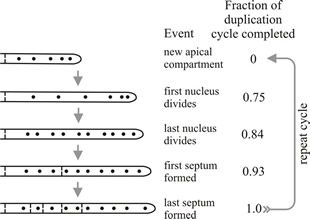4.7 Duplication cycle in moulds
Cell separation does not occur in filamentous fungi, yet it is possible to interpret events during fungal growth as analogous to those that comprise the duplication cycle of unicellular organisms. The main morphological events in the duplication cycle in Aspergillus nidulans are as follows (Fig. 14)(Fiddy & Trinci, 1976):
- As the final step in the previous cycle, the apical compartment is reduced to about half its original length by the formation of two to six septa (cross-walls) at the rear of the compartment.
- The newly formed apical compartment continues to increase in length at a linear rate and the nuclei migrate towards the hyphal tip at a slightly slower rate.
- The volume of cytoplasm per nucleus increases until, at a critical ratio, the nuclei are induced to divide more or less synchronously (a single mitosis takes 5 minutes, and it takes about 12 minutes for the mitosis of all 50 nuclei found in the average apical compartment of A. nidulans.
- Mitosis is followed, during the final 7% of the duplication cycle by the formation of two to six septa in the rear of the apical compartment, reducing its length by half.
 |
Fig. 14. Diagrammatic representation of the duplication cycle in a leading hypha of Aspergillus nidulans extending at a linear rate on solid medium. On average, completion of a duplication cycle takes 2.1 hours; therefore a 0.1 fraction of the duplication cycle is equivalent to about 12.5 min. Redrawn after Trinci, 1979. |
The duration of a duplication cycle in apical compartments of leading hyphae of Aspergillus nidulans (2.1 hours) is identical to the doubling time of the organism in liquid culture; another indication that extension of apical compartments is unrestricted. In nature, Aspergillus nidulans has about 50 nuclei in each apical compartment, but duplication cycles of this sort have been described in apical compartments of leading hyphae of species that were monokaryotic (one nucleus per compartment), dikaryotic (two nuclei per compartment) and multinucleate (up to about 75 nuclei per compartment).
The indications are that synchronous mitosis in apical hyphal compartments of leading hyphae is regulated by a size-detecting mechanism similar to that observed in the fission yeast Schizosaccharomyces pombe, where mitosis is triggered when the ratio [cytoplasmic volume]:[number of nuclei] exceeds a critical value.
An important point of contrast between the duplication cycle of fungi and those of animals and plants is that in fungi there is no necessary quantitative or spatial relationship between division of the nuclei and division of the cytoplasm by cross-wall formation (septation). Contrast the diagram in Fig. 14 with the situation in an animal cell in which one mother cell is divided into two mitotic daughters by a cleavage furrow across the equator of the division spindle; and with that in a plant cell in which one mother cell is divided into two mitotic daughters by a new cell wall (cell plate) appearing across the equator of the division spindle. In contrast, mitoses of the 50 nuclei in the average apical compartment of Aspergillus nidulans are not accompanied by formation of 50 septa. There is, of course, a temporal relationship between karyokinesis and cytokinesis in fungi (septation occurring towards the end of the duplication cycle) but there is no strict arithmetical relationship of the sort ‘one division spindle = one septum’.
Updated July, 2019
